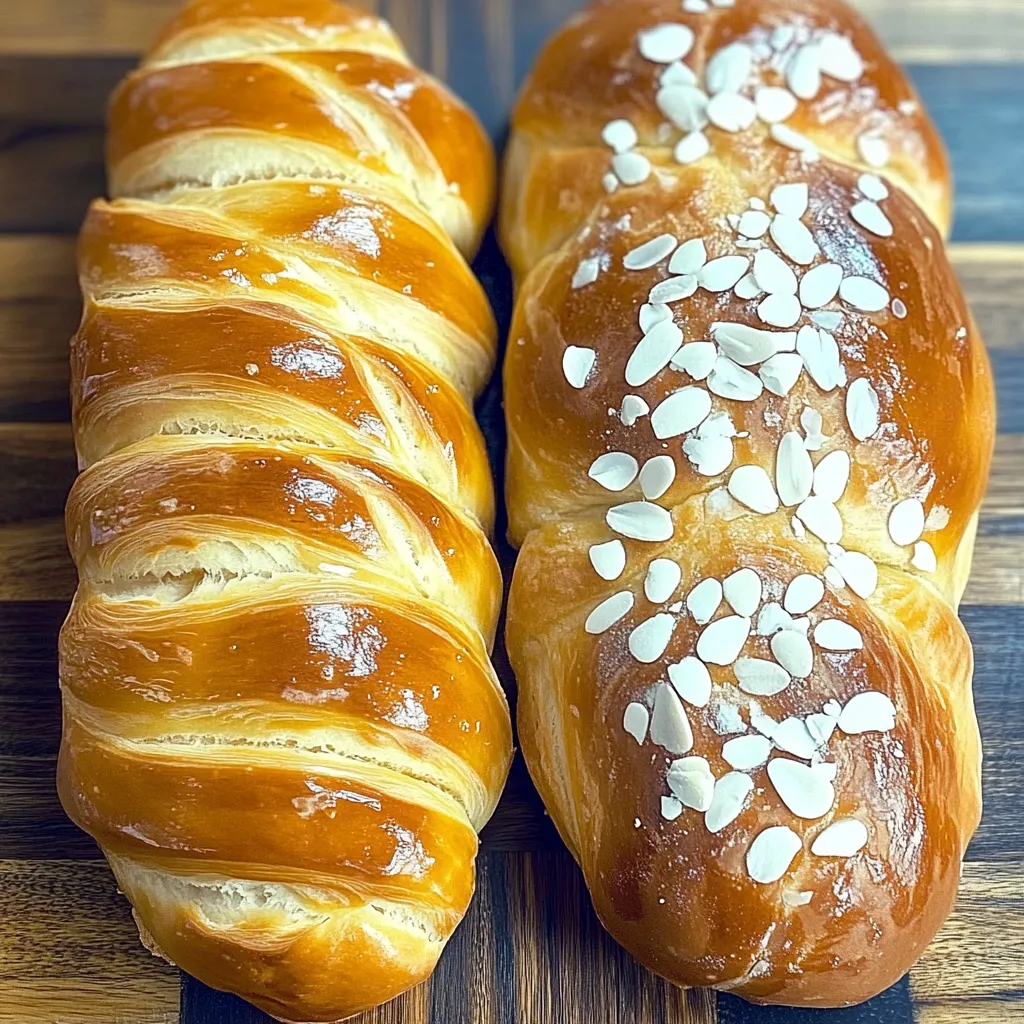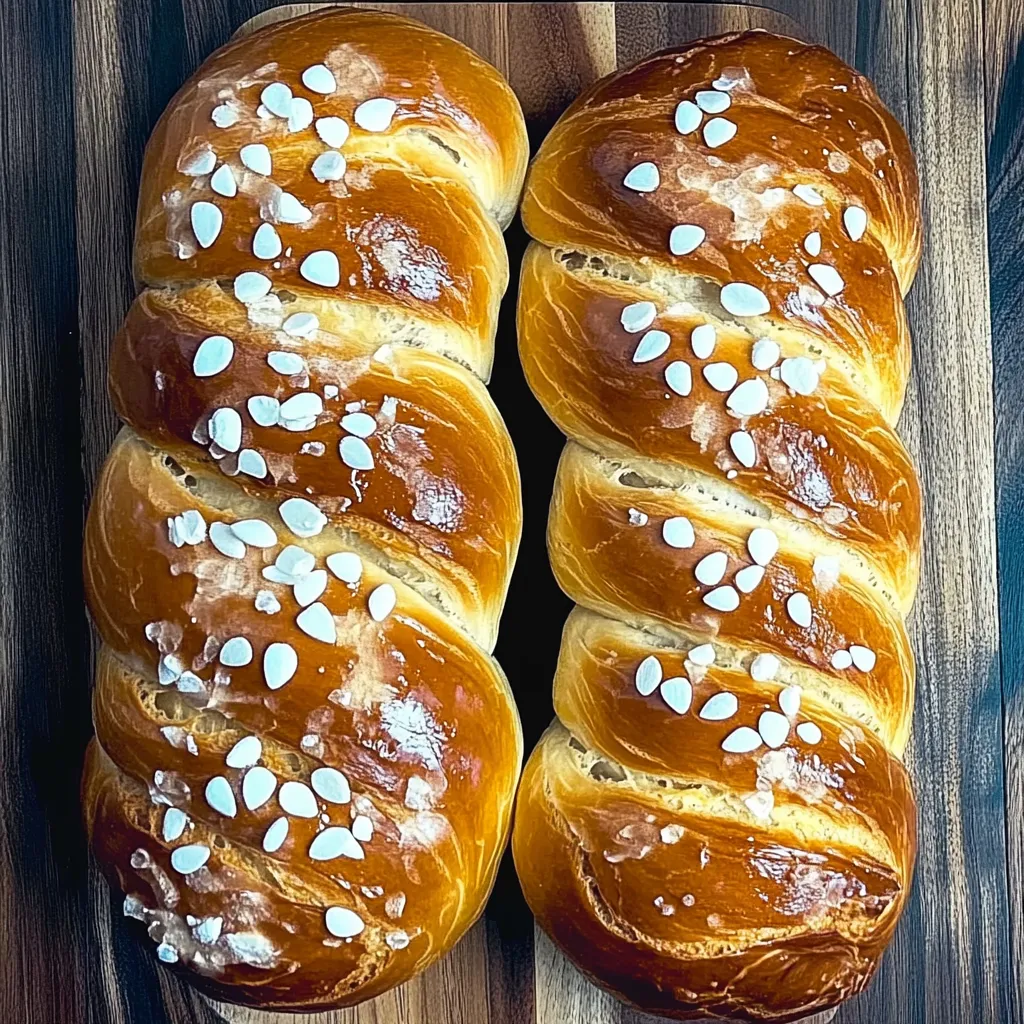 Pin it
Pin it
This traditional Tsoureki brings the essence of Greek Easter celebrations to your home with its soft, pillowy texture and aromatic spices. The sweet bread has been part of my family's Easter traditions for generations, filling our home with irresistible aromas that signal the arrival of spring celebrations.
I first learned to make Tsoureki alongside my grandmother, whose hands worked the dough with practiced precision. Even today, the ritual of braiding these sweet loaves brings back memories of those special mornings in her kitchen, with flour dusting every surface.
Ingredients
- High protein bread flour: Creates the perfect structure and soft texture
- Mahlepi spice: Brings its characteristic cherry-almond aroma essential to authentic Tsoureki
- Mastica resin: Adds a subtle pine flavor that distinguishes Greek baking
- Orange zest: Brightens the rich dough with citrus notes
- Cardamom: Enhances the aromatic profile with warm spicy undertones
- Sesame seeds or sliced almonds: Provide traditional decoration and pleasant texture
Step-by-Step Instructions
- Proofing the Yeast:
- Combine flour, sugar, and yeast with warm water in a bowl and mix thoroughly. Allow the mixture to sit undisturbed until it becomes foamy and active. This activation process is crucial for ensuring your dough rises properly and achieves that light, airy texture.
- Creating the Aromatic Base:
- Mix all dry ingredients including flour, sugar, ground spices, salt, and orange zest in a large bowl. These aromatic elements are the soul of Tsoureki, with mahlepi and mastica providing that unmistakable Greek Easter bread fragrance that fills your kitchen.
- Forming the Enriched Dough:
- Pour in milk, eggs, melted butter, vanilla, and activated yeast mixture to your dry ingredients. Work everything together until fully incorporated. The enriched dough should feel soft and slightly sticky between your fingers, indicating the perfect moisture balance.
- Kneading to Perfection:
- Transfer dough to a clean surface and knead vigorously for at least 10 minutes until smooth and elastic. This extended kneading develops the gluten structure that gives Tsoureki its characteristic texture. The dough should feel tacky but not stick heavily to your hands.
- First Rise:
- Place the dough in an oiled bowl, cover with plastic wrap, and let rise in a warm spot until doubled in size. This slow fermentation allows the flavors to develop and the yeast to create the airy pockets throughout the bread.
- Shaping and Braiding:
- Divide the risen dough into 18 equal portions and roll each into 40cm ropes. Working with three pieces at a time, braid them together to form a traditional Tsoureki loaf. The braiding not only creates a beautiful presentation but also ensures even baking.
- Second Rise:
- Place braided loaves on parchment-lined baking dishes, ensuring they have room to expand. Cover and allow to rise until noticeably puffed but not quite doubled. This second rise creates the perfect final texture.
- Finishing and Baking:
- Brush loaves with egg wash for a glossy finish, sprinkle with sesame seeds or almonds, and bake at 170°C until golden brown. The aroma that fills your kitchen during this final stage is the reward for all your patient work.
 Pin it
Pin it
The aromatic mahlepi spice comes from ground cherry pits and truly makes this bread special. The first time I found real mahlepi at a specialty Greek market, I noticed an immediate difference in my Tsoureki. That subtle almond-cherry aroma transported my Greek relatives back to their childhood Easters with just one bite.
Finding the Specialty Ingredients
Mahlepi and mastica can be found in Greek or Middle Eastern markets, specialty spice shops, or online. These ingredients are worth the effort to locate as they provide the authentic flavor that makes Tsoureki truly special. If you absolutely cannot find mahlepi, a blend of ground anise and fennel seeds can provide a somewhat similar aromatic quality, though the flavor profile will be different.
Serving Traditions
In Greek homes, Tsoureki is traditionally served on Easter Sunday following the Lenten fast. The bread is often accompanied by hard-boiled eggs that have been dyed red to symbolize the blood of Christ. When serving, consider pairing with Greek coffee in the morning or a glass of sweet Mavrodaphne wine for an afternoon treat. The bread also pairs beautifully with various spreads like honey, jam, or traditional Greek spoon sweets.
Storage Solutions
Tsoureki maintains its freshness remarkably well compared to other homemade breads. To keep your loaves at their best, allow them to cool completely before wrapping tightly in plastic wrap. Store at room temperature for up to 5 days. For longer storage, freeze well-wrapped loaves for up to 3 months. To refresh slightly stale Tsoureki, warm gently in a 150°C oven for 5-10 minutes.
 Pin it
Pin it
With Tsoureki, you can bring a special touch of Greek Easter traditions to your home, creating both memories and delicious results with every braid.
Frequently Asked Questions
- → What are mahlepi and mastica in Tsoureki?
Mahlepi (or mahlab) is a spice made from ground cherry pits with a distinctive cherry-almond flavor essential to authentic Tsoureki. Mastica is a resin from the mastic tree found primarily on the Greek island of Chios, adding a subtle pine-like aroma. Both these traditional ingredients give Tsoureki its unique flavor profile and are what distinguishes it from other sweet breads.
- → Can I make Tsoureki ahead of time?
Yes, Tsoureki can be made 1-2 days ahead of when you plan to serve it. Once completely cooled, wrap it tightly in plastic wrap to maintain freshness. If needed, you can also freeze Tsoureki for up to 3 months. To serve after freezing, thaw at room temperature and warm slightly in the oven to refresh the texture.
- → Why does my Tsoureki need to rise twice?
The double rise is crucial for developing Tsoureki's characteristic texture. The first rise develops flavor and gluten structure in the dough. The second rise, after shaping, allows the braided loaves to expand properly, creating that soft, fluffy interior with a slightly chewy texture that Tsoureki is known for. Skipping either rise would result in a denser, less developed bread.
- → What can I substitute for mahlepi or mastica if I can't find them?
While traditional Tsoureki gets its distinctive flavor from these spices, you can substitute mahlepi with a mixture of ground anise and ground fennel seeds (1:1 ratio). For mastica, try using a combination of vanilla extract and a small amount of ground bay leaf. The flavor won't be identical, but you'll still achieve an aromatic bread. Alternatively, ground cardamom and orange zest can help enhance the flavor if you're missing the traditional spices.
- → How do I know when my Tsoureki is properly kneaded?
Properly kneaded Tsoureki dough should be soft and slightly sticky but shouldn't stick heavily to your hands or the work surface. The dough should be elastic enough to stretch without immediately tearing (the window pane test). When you press a finger into the dough, it should slowly spring back. Given the high butter and egg content, Tsoureki dough will remain softer than regular bread dough even when properly kneaded.
- → How should I store leftover Tsoureki?
Store completely cooled Tsoureki in an airtight container or wrapped tightly in plastic wrap at room temperature for up to 3-4 days. To extend freshness, avoid refrigerating as this accelerates staling. For longer storage, slice and freeze Tsoureki, removing only what you need. Gently toast frozen slices to revive their texture and flavor.
